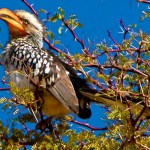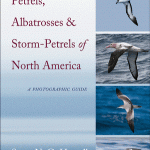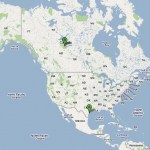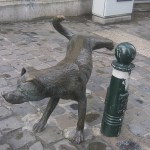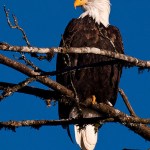birds
The season cycled over the weekend - officially it is not quite spring, but in fact, spring now has a toe hold. Even if it goes back to chilly or even snows, the ground is too warm for it to last, by the end of an unusually warm week the grass will be green and the soil dried enough to move forward. That doesn't mean my (optimistic) plantings of peas and bok choy, spinach and sweet peas may not stagnate or my fruit tree blooms get caught by frost (we can't even say a late frost, it is two months to my last frost date, and anything can happen in upstate NY and usually does), that the boys in…
All of my Bird Book Reviews are Here, and some of the reviews include broader discussions that go beyond the book, so do browse through them.
Feeding Birds:
Should you even be feeding the birds to begin with?
Birders get annoyed at squirrels for obvious reasons. But you can be happier about the squirrels in your yard if you just change your attitude and see the gray squirrels as food!
Watching Birds
What makes for a good bird?
The falcon eats tonight ...
The Science of Birdwatching
Let the Eagle Soar
We Walk Among Ducks In Wolves Clothing. And Wolves.
Ducks Blowing In The Wind
When is a…
Did you know that there is an entire group of birds called "Tube Noses" because they have tubes on their noses? Well, to be more exact, the term is "tubenoses" and the noses are beaks. The tubes are tubular nostril-like thingies that most (all?) birds have which are extra tube-like in the tubenoses. Thus the name.
Albatrosses, petrels, and storm-petrels, which includes shearwaters, make up the tubenoses, and the newly produced book Petrels, Albatrosses, and Storm-Petrels of North America: A Photographic Guide is about the North American species of this order, scientifically known as the…
How are birds related to dinosaurs, crocodiles, and pterosaurs? Where do birds live, and not live? How many bird species are there, and how many actual birds, and how does this vary across the glob? What about endemics?; Where ate the most local species found? Mike Unwin's The Atlas of Birds: Diversity, Behavior, and Conservation covers this and more in a richly illustrated detailed global survey of Aves.
This new and very impressive, and highly accessible volume covers bird biogeography with an overview of counts and diversity followed by a continent-by-continent review, to give you an idea…
Birds don't live in nests. They make nests for specific purposes, use them for that purpose, then abandon them. Or, sometimes they don't abandon them, but rather add on and use them again and again, but in between they don't live in or on them. Well, sometimes they hang out on them a lot. And not all nests are for putting their eggs in. In fact, sometimes a nest is more of a symbol of quality and overall bird sexiness than it is a place to keep the chicks. As it were. Oh, and sometimes they live in the nests, now that I think about it ... It's complicated.
But there is a book that…
People who watch birds identify them, and that process is integral to what makes birding interesting. But the best practices for identifying birds appear on the face of it to conflict with evolutionary concepts of birds, and this can lead to both sloppy thinking and missed opportunities
People who watch birds identify them, and that process is integral to what makes birding interesting. But the best practices for identifying birds appear on the face of it to conflict with evolutionary concepts of birds, and this can lead to both sloppy thinking and missed opportunities.
You need to know…
The first crane I ever saw is a bird burned permanently in my memory. It came out of nowhere and flew close by, staying in view lit by a nearly setting sun for about five wing beats. A gun was raised to shoot it but the trigger was not pulled.
I was a teenager, and the brother of a co-worker invited me to go hunting with him. The idea was not for me to actually hunt, but rather, for me to see what hunting was all about. It was a social gesture and a manly gesture. If I like hunting perhaps I would join one of their hunting groups, get a firearm, learn to shoot, and become one of the boys…
Corvids are among the smartest animals on the planet, and Mo reports that the United States military considered tactical uses for their intelligence. The dream of "spy crows" sprang from research conducted at the University of Washington, where researchers donned rubber masks in the likenesses of Dick Cheney and 'cavemen' to study facial recognition among crows. Perhaps untrue to form, the cavemen molested the crows while the Dick Cheneys left them alone. For months and even years afterward, the crows harassed anyone seen wearing a caveman mask on campus. Now all the Pentagon needs is…
They used to hunt whooping cranes. Between that and habitat loss, the number dropped from nearly 20,0000 to a mere 1,400 during the first half of the 19th century, and continued to drop to an all time low of 15 birds in 1941.
Fifteen birds, in 1941, represented the entire species.
All those birds were members of a single flock that migrated between the Aransas National Wildlife Refuge in Texas, USA and Wood Buffalo National Park in Canada.
Most people know the story, or at least, the vague outlines of the story. Much has been written about them, including several books such as Cranes:…
These are the kinds of books you get if you are either a scientists studying bird migration and related issues, or a very serious bird geek. The first two can be obtained at very low prices used, but the third will set you back at least 50 bucks US$ if you want a used copy. Note the spread of publication dates. It is not the case that the oldest book is out of date in all respects: Quite the contrary. Alerstam reviews theory and ideas that have not been revisited or revised to any great degree. Also, it is interesting to see how changes in the field develop over a decade or so. In any…
This post at 10,000 Birds, an item I accidentally bumped into on the Internet while looking for something else, and an unusual sighting moments ago, converge. And, its a nice distracting convergence which I need right now because as I sit here one week before fishing opener, looking at the glassy surface of Hunters Bay, I see fish jumping everywhere. Not only that, but a 54 inch muskie was found dead a few days ago 25 feet from where I'm sitting now. And, the Department of Natural Resources put up a fish weir just across the bay, and they've been coming by every morning and pulling out…
I was reading Christie's excellent post (and you should too) on GoDaddy CEO Bob Parsons' elephant killing incident (is it too early to be calling this #ElephantGate?)
Although I don't know quite enough about what is going on in Zimbabwe, I tend to err on the side of not intentionally killing elephants because - as I argued for the case of chimpanzees - they are very likely self-aware.
I wrote:
There is another important cognitive capacity that unites animals with high encephalization quotients (the ratio of brain to body size - I recommend going back to read my earlier post for the context…
I've got a new piece over at the Scientific American Guest Blog:
On Friday, March 11, Japan was rocked by an earthquake. People were displaced, a nuclear reactor was in trouble, and the world watched as a tsunami flooded Japan, threatened the islands of the Pacific, and ultimately hit the western coasts of North and South America. Chris Rowan pointed out that "Very little of the devastation resulting from this earthquake was from the initial shaking. This is partly because of Japan's stringent building codes. But mainly because any damage from the seismic waves that sent skyscrapers in Tokyo…
Welcome to Territoriality Week! Every day this week, I'll have a post about some aspect of animal or human territoriality. How do animals mark and control their territories? What determines the size or shape of an animal's territory? What can an animal's territory tell us about neuroanatomy? Today, I begin by asking two questions: first, what is the functional purpose of establishing territories? Second, to what extent can we apply findings from research on animal territorial behavior to understanding human territorial behavior?
It seems that everyone becomes an amateur animal behaviorist…
It's like a scene out of Romeo and Juliet, or perhaps the Rapunzel story. A wild bald eagle has taken up residence on a tree just adjacent to a bald eagle enclosure at the Orange County Zoo in Irvine, near Los Angeles. In fact, the wild bird has shown particular interest in the zoo's 6-year-old female bald eagle, Olivia.
According to LAist:
In fact, the pair have been chatting it up--well, squawking back and forth, as the Zoo manager explains, and seem to have struck up a friendship. Is it bald eagle love? Zookeepers aren't sure, since they don't know the sex of the visiting bird, though its…
What's the best way for a lonely guy to get a date? If you're a Splendid Fairy-Wren (Malurus splendens, native to Australia), your best bet might be to frighten the object of your affection.
You've learned all about the birds and the bees; now it's time to learn from them.
Lots of research has shown that animals reduce their sexual behaviors when predators are around. After all, it isn't just potential mates who would see or hear an elaborate mating display, but also potential predators. The male splendid fairy-wren does something a little bit unusual, though. Gray Butcherbirds (Cracticus…
Over the last few days, there have been several reports of mass die-offs of birds, and one report of a fish die-off. These events have been linked, via suggestion but not evidence, to hail, lightning, fireworks, aircraft, aliens, each other, poison gases, and even pockets of oxygen free air. Many have suggested that there may be a cover up. What is the explanation for so many highly unlikely events happening in such a short time period?
The answer may astound you:
Nothing.
According to available records, close to a hundred mass die-offs of birds occur each year in the US. The recent…
In the renowned yet obscure documentary, "Dead Birds," watchful men in a traditional community in Highland Papua New Guinea use the sudden flight of birds as a clue to the possible encroachment of a hidden enemy bent on blood revenge. In mines, canaries signal air too poisoned to breath by dying faster than affected humans. And in Arkansas, apparently, the sudden death of thousands of blackbirds are used to indicate the nefarious activities of aliens from another planet.
These unexplained (or actually, over explained) instances of blackbird death, one a few days ago in Arkansas and one…
One day, about ten years ago, we were having a strong southerly fetch with small tornadoes popping out of the stormy front, so Julia and I were keeping an eye out the windows, watching wall clouds form and unform over our heads. Then, suddenly, there were these two ducks flying south, coming up over the houses across the street. They flew up into the air and beat their wings against the strong wind, not making any ground at all, and then finally, fell back out of our view. I'd seen these ducks before. By day they foraged to the north on the Metronics property, but roosted to the south,…
Even still, we tend to think of the turkey as a fairly unintelligent bird, skilled at little more than waddling around, emitting the occasional "gobble," and frying up golden-brown-and-delicious. But...what if I told you that the domestic turkey (Meleagris gallopavo) could actually be quite clever, at least when it comes to social cognition? Apocryphal or not, Ben Franklin may have been on to something with the "Bird of Courage."
Head on over to Scientific American to catch my latest contribution to their Guest Blog: Turkey talk: The social cognition of your Thanksgiving dinner
Buchwalder, T…
